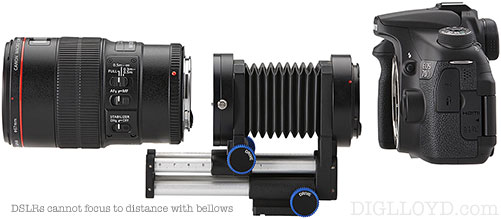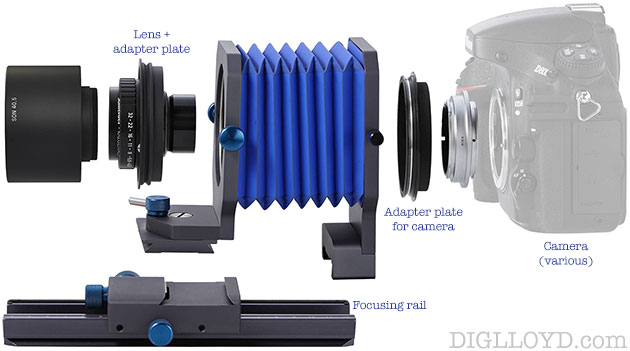Bellows Systems for Nikon, Canon, Leica, Sony: Why Consider Them?
See my Cambo Mini View Camera wish list at B&H Photo.

Get Novoflex bellows and Novoflex Auto Bellows for Canon EOS at B&H Photo.
Recently discussed: Cambo Actus Mini View Camera and Novoflex bellows systems.
Bellows systems appear to offer view camera functionality when used with mirrorless cameras. When I say “appear” I mean only that I have not tested specific systems to see if the hardware allows infinity focus with DSLR lenses. I’m looking into it.
A bellows system a number of benefits to some kinds of work:
- Extreme enlargement by adding close focusing capability.
- Movements: rise and fall, left and right shift, tilt. (Some of these movements might not be available, depending on the system).
- Focusing by moving the camera on the rear standard along the focusing rail, which keeps the entrance pupil in a fixed position for parallax-free images as well as a constant focal length.
- A wide range of lenses can be adapted.
Bellows systems have generally been for close-up and macro work with DSLRs. That’s because a bellows system used with a DSLR camera and a DSLR lens allows closeup focusing only. For a macro or closeup shooter, the ability to focus beyond a few feet might be of no concern. But for all-around use, including use in the field, focus from medium range to infinity is a requirement.
With mirrorless cameras, about an inch of flange focal distance exists, and so for the same reasons Sony mirrorless system can take Nikon and Canon and other DSLR lenses (with adapter), a bellows system may be able to reach infinity focus if the interposed parts are within the required spacing. For example, the Cambo Actus Mini View Camera reaches infinity focus with Nikon (Nikon, Zeiss, Coast, etc) or Canon DSLR lenses.
The mirrorless camera flange-focal difference potentially allows bellows systems to focus DSLR lenses to infinity on mirrorless cameras. Whether this is possible depends on the particulars of the bellows system hardware and brand of lens [Canon lenses have 2mm more flange offset than Nikon, which is why Nikon lenses can be used on Canon with a 2mm-thick-lens adapter, but not vice versa].
Continues below...
As shown below, this Novoflex Auto Bellows for Canon EOS is for high magnification macro work only because the bellows system inserts a large spacing between the lens and the camera. But if the camera were a Sony mirrorless camera, the situation changes. In this case, it’s unclear if Novoflex offers a Canon lens mount + Sony camera mount that is also electronically coupled. For this reason, Nikon F-mount lenses with aperture rings are much more interesting for all-around use.

Considerations in choosing a bellows system
Factors in considering a bellows system:
- Compatibility: cameras bodies, which lenses, and whether specially optimized lenses are available for specific workflow (macro, architecture, etc).
- Compatibility: Canon lenses, some Nikon lenses require electronic aperture control. For this reason, lenses like Zeiss DSLR lenses in Nikon F mount are greatly preferred because they have an aperture ring; the issue goes away.
- Compatibility: specific cameras may have a body shape that don’t allow the camera to mount or focus fully.
- Practical limits: shift limits may exist; the lens mount blocks cone of light at some amount of shift.
- Whether infinity focus with DSLR is possible (with a mirrorless camera)
- Size and weight: if hiking or travel is involved a system weighing 10 pounds is out of the question. The Cambo Actus Mini view camera with lens plate is about 1220 grams. The Novoflex system is also quite light.
- Movements: does the system offer tilt and swing, rise and fall and shift? If so, which operations on the front standard and rear standard? This matters a lot to some uses, since movements to the front standard change perspective, whereas movements with the rear standard do not (think stitching and focus stacking in particular). A minor but useful point is whether tilt of the rear standard is centered or not.
- Availability, service, warranty, cost.

Specific uses: tilt for depth of field
Tilt and/or swing can alter the zone of focus to follow the shape of the subject, effectively making huge gains in depth of field for a compatible subject shape.
Canon TS-E and Nikon PC-E lenses offer a built-in tilt capability. A bellows system that offers a tilt feature effectively makes any lens into a tilt lens (and rise/fall/shift if the system also offers that).
Besides tilt and shift, using the rear standard to focus keeps the entrance pupil and focal length of the lens constant, which is the ideal approach to focus stacking.
Specific uses: focus stacking
With focus stacking, a change in focus is often accompanied by a change in focal length, particularly at close range or macro shooting. Similarly, a change in focus might also change the position of the entrance pupil, which causes a change in perspective.
A bellows system is the ideal solution for focus stacking because it allows focusing to be done by moving the rear standard (which has the camera attached). The front standard + lens does not move, thus the lens is never refocused after its initial focus setting, and thus the entrance pupil remains in a fixed position with focusing, keeping both focal length and perspective unchanging throughout the stack of images.
Specific uses: stitching
Shifting left right (or rise and fall) can be used on the rear standard for parallax-free images which can be stitched into one higher resolution image.
By comparison, stitching images with a shift lens (Nikon PC-E or Canon TS-E) causes a change in perspective, generating parallax—because the lens moves (the entrance pupil changes position). This wreaks havoc with stitching (try stitching the arc of a drooping wire between telephone poles!). The work around is a counter-shift of the camera within its clamp, which works well if one remembers and gets it just right.

























